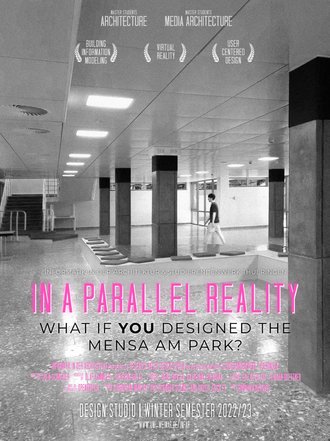
IN A PARALLEL REALITY – What if you have designed the „Mensa am Park“
Design Studio, Winter 2022/23
Buildings are made for humans. So, the design of buildings requires architects to anticipate how humans will experience and behave in the planned environment. However, this is not an easy task due to the vast amount of influencing factors coming from the physical environment (such as geometry, light, color) and from the users themselves (different social backgrounds, abilities, expectations, age, etc.). This challenges the design of buildings and results in the fact that even architecturally remarkable buildings, are sometimes hard to understand for building users. We might ask, can’t science support designers here?
The role of science in design can be seen in identifying regularities in natural phenomena that can be used in the definition of building parameters. Whereas physical sciences found their way into the design of buildings (such as structural and thermal behaviour), sciences dealing with human behaviour and emotions (e.g. environmental psychology) are widely lacking such an integration.
In this project we will try to bridge the gap between architectural design and environmental psychology. Therefore, we first will learn how to evaluate built environments in terms of human-centred aspects such as wayfinding, social interaction and spatial experience. Second we will develop a design strategy that anticipates the ‘human-perspective’ in the creation of spaces. As a case we will use the reconstruction of the ‘Mensa am Park’. This building was recently reconstructed, however, seems to not fully address the requirements for a contemporary university canteen. So, we ask: “What if we could try again and create a better version of the building?”
Therefore, we will first conduct a user study in the existing building and systematically identify strengths and weaknesses in relation to user experience. Second, we will develop ideas for improving the building. Third and finally, the designs are modelled in 3D and tested using computational spatial analyses and a Virtual Reality based User Study.
The project is accompanied by two seminars: “Computational Methods for User-Centered Architectural Design” and “Parametric Building Information Modeling”, which are mandatory for this project.
Study program: Architecture, Media Architecture
Credits: 12 ECTS
Lecturer: Vertr.-Prof. Dr.-Ing. Sven Schneider, M.Sc. Olaf Kammler
Date and Place: Thursday, 9:15 - 16:45
--> Link to Moodle
--> Link to BISON
